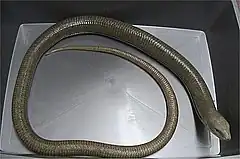Pseudopus
Pseudopus is a genus of anguid lizards that are native to Eurasia.[1] One extant species remains, the sheltopusik,[2] with four fossil species. They are the most robust members of subfamily Anguinae.[1][3] The oldest fossils of the group date to the Early Miocene, but there are possible Oligocene records.[4]
| Pseudopus Temporal range: | |
|---|---|
 | |
| Scientific classification | |
| Domain: | Eukaryota |
| Kingdom: | Animalia |
| Phylum: | Chordata |
| Class: | Reptilia |
| Order: | Squamata |
| Family: | Anguidae |
| Subfamily: | Anguinae |
| Genus: | Pseudopus Merrem, 1820 |
| Type species | |
| Lacerta apoda Pallas, 1775 | |
Classification
- Pseudopus apodus (Pallas, 1775) – sheltopusik, Pallas's glass lizard, European legless lizard, European glass lizard
- †Pseudopus ahnikoviensis
- †Pseudopus laurillardi
- †Pseudopus pannonicus
- †Pseudopus rugosus
References
- Klembara, Jozef; Madelaine Böhme; Michael Rummel (2010). "Revision of the anguine lizard Pseudopus laurillardi (Squamata, Anguidae) from the Miocene of Europe, with comments on paleoecology". Journal of Paleontology. 84 (2): 159–196. doi:10.1666/09-033R1.1. S2CID 130738857.
- Pseudopus at the Reptarium.cz Reptile Database. Accessed 27 May 2014.
- Jozef Klembara (2015). "New finds of anguines (Squamata, Anguidae) from the Early Miocene of Northwest Bohemia (Czech Republic)". Paläontologische Zeitschrift. 89 (2): 171–195. doi:10.1007/s12542-014-0226-4. S2CID 129436097.
- Villa, Andrea; Delfino, Massimo (November 2019). "Fossil lizards and worm lizards (Reptilia, Squamata) from the Neogene and Quaternary of Europe: an overview". Swiss Journal of Palaeontology. 138 (2): 177–211. doi:10.1007/s13358-018-0172-y. ISSN 1664-2384.
This article is issued from Wikipedia. The text is licensed under Creative Commons - Attribution - Sharealike. Additional terms may apply for the media files.